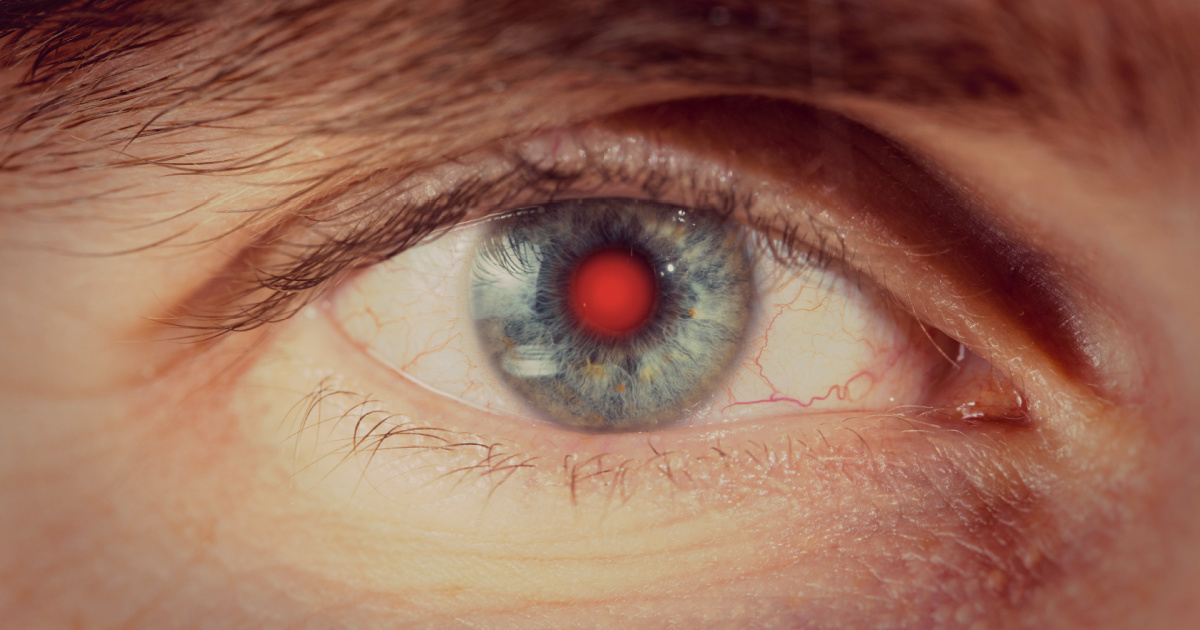Taking the perfect photo often means contending with various challenges, from the right lighting to making sure everyone is looking in the right direction. However, one common issue that frequently messes up an otherwise flawless picture is the unsettling “red eyes” phenomenon in photos. The unsettling sight comes from an optical illusion, and a deeper understanding of the underlying reasons has emerged.
The Red Eye Effect Unveiled
The consistency of red eyes in photographs has puzzled both amateur and professional photographers alike. Although it has been used in several meme formats, this look is not ideal for the day-to-day photograph. Contrary to popular belief, the unsettling hue does not result from a camera flash.1 Instead, it is a consequence of the interplay between light and the anatomy of the human eye.
To understand how the red eye effect came to be, we need to look at the eye’s structure. The eye is a hollow sphere filled with clear fluid, with the inner back surface (called the retina) responsible for detecting light. This critical component is densely packed with light-sensitive cells that, when illuminated, reflect light back while revealing the blood-rich tissues that nourish the retina.
The intensity and angle of the light source also play a pivotal role in accentuating the redness of the eyes in photographs. Under normal conditions, the red color of the retina remains hidden as the eye itself acts as a light-absorbing chamber.2 But, when subjected to a bright and focused light, like a camera flash, the reflective properties of the retina become more pronounced, resulting in the distinctive red-eye effect in the picture.
Mitigating Red Eyes
Efforts to control the red-eye effect have led to the development of various techniques and technologies designed to minimize its occurrence. Many cameras and phones feature a “red-eye reduction” function, which involves pre-flashing to induce pupil constriction before the actual picture is taken, therefore reducing the retina’s reflective properties.3 Additionally, adjusting the positioning of the flash or increasing ambient lighting can help reduce the likelihood of red eyes appearing in photos. If the eye is already adjusting to a relatively bright space, the reflections from the eyes won’t be as intense when the photo is developed.
Armed with a deeper knowledge of how to influence the red eye effect, photographers are better equipped to refine their techniques and equipment choices to minimize its occurrence. By using strategies like as adjusting lighting conditions and utilizing specialized camera features, photographers can enhance the overall quality of their images while mitigating visual distortions.
Upon learning the scientific explanation behind the red-eye effect, many individuals have expressed a range of emotions, from surprise to mild unease. The newfound awareness that the crimson hue originates from the blood vessels in the eyes has prompted some to view their photographs with a renewed sense of curiosity and introspection.
Concluding Thoughts
The revelation of why pupils go red in photos offers a compelling glimpse into the complex interplay between light and anatomy. While initially disconcerting, science empowers us to use practical strategies to minimize this visual distortion in our photographs. Armed with this knowledge, we can strive to take more flattering images, free from the unsettling glare of red eyes.
By unraveling the underlying mechanisms behind this optical illusion, individuals gain valuable insights that inform their approach to photography and deepen their appreciation for the intricacies of human vision. Photographers can navigate the challenges of capturing captivating images with greater precision and finesse while continuing to marvel at the wonders of perception and cognition.
Read More: 13 things that happen to your body when you’re under anesthesia
Sources
- “People creeped out after learning why your pupils go red in photos.” Lad Bible. Olivia Burke. February 19, 2024.
- “Why do camera flashes make your eyes turn red?” WTAMU. May 1, 2013
- “Why do people have red eyes in flash photographs?” How Stuff Works

